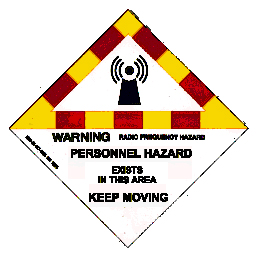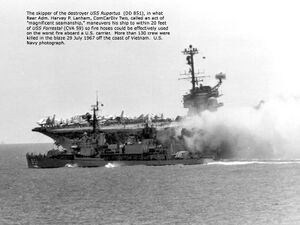Safety and survivability of naval vessels
Template:TOC-right Most modern warships have high-power radar and radio equipment that require significant safety precautions. [1]Aircraft carriers and warships operating helicopters also offer the danger of being run over by aircraft, sucked into jet engines, cut in half by a snapped arresting wire.
These hazards are present in peacetime, when the sea is both friend and foe. In active warfare, natural and "friendly" threats are joined by other people using their best ability to do more damage than the sea.
No man will be a sailor who has contrivance enough to get himself into a jail; for being in a ship is being in a jail, with the chance of being drowned... a man in a jail has more room, better food, and commonly better company — Samuel Johnson
Compartmentation
Flooding and fire protection
Chemical, biological and radiological protection
Electromagnetic Hazards
Hazards of Electromagnetic Radiation to Personnel (HERP)
Radar and communication systems, which use high-power RF transmitters and high-gain antennas represent a biological hazard to personnel working on, or in the vicinity of, these systems. The detrimental effects of overexposure to RFR are associated with an increase in overall body temperature or a temperature rise in specific organs of the body. High-level electromagnetic energy can also induce electrical currents or voltages that may cause shocks and burns. An RF burn is the result of RF current flow through that portion of the body in direct contact with a conductive object (in which an RF voltage has been induced) or at the site/+ of a spark discharge (no direct contact with a conductive object).
The use of HF transmitters (1 kilowatt and up) and the complicated structure and rigging aboard ship, especially cargo ships, has increased the probability of voltages being induced on various objects. The handling of metallic cargo lines while shipboard HF transmitters are radiating can be hazardous to ship’s personnel. On numerous occasions, RF voltages have been encountered on items such as crane hooks, running rigging, booms, missile launchers, and parked aircraft. These voltages, which may be sufficient to cause injury, are induced on the metallic items by radiation from nearby transmitting antennas.
In addition to electromagnetic radiation hazards, there are other physical hazards to Navy personnel working aloft on shipboard radar antennas. Working aloft presents a fall hazard. In addition, rotating antennas might accidentally be energized causing an injury from contact or a fall.
Hazards of Electromagnetic Radiation to Fuel (HERF)
Fuel vapors can be ignited by RF induced arcs during fuel handling operations close to high powered radar and radio transmitting antennas. For example, many ships carry at least one helicopter or have the ability to refuel a helicopter and carry fuel to support helo operations.
Hazard of Electromagnetic Radiation to Ordnance (HERO)
The high intensity RFR fields produced by modern radio and radar transmitting equipment can cause sensitive electrically initiated devices (EIDs), classically known as electro-explosive devices (EEDs), contained in ordnance systems to actuate prematurely. RFR energy may enter an ordnance item through a hole or crack in its skin or through firing leads, wires, and so on. In general, electrically initiated ordnance systems are most susceptible during assembly, disassembly, loading, unloading, and handling in RFR electromagnetic fields. The potential dangers to ordnance and fuels are obvious because there could be an explosive chain reaction.
Other electrical problems can affect ordnance. In the image, fire, 134 men were killed and 161 injured, started when an Zuni air-to-ground 5" rocket, aboard an F-4 Phantom II fighter, piloted by Jim Bangert fired, when it was switched from external to internal electrical power. [2] The rocket and its launching triple ejector rack each had a separate electrical connector that enabled the rocket to be launched. The two arming connectors were to be inserted, under standard operating procedures, only when the aircraft was on the catapult, weapons aimed in a safe direction. To improve speed, the ship's Weapons Coordination Board approved the early insertion of one of the pins. Unfortunately, the WCB board never forwarded its recommendation to higher authority, and, without consultation, flight deck crews had also decided to find a faster way to launch, by pre-inserting a connector.
Unfortunately, that connector was the second of the two. Each group assumed that the other pin was not yet installed, so the fighter was moved along the deck with both arming pins in place. When the rocket fired, it shot across the deck and hit an A-4 Skyhawk attack aircraft piloted by John McCain, tearing open its fuel tank and starting a major fire, which, in turn, set off bombs.
Explosive ordnance safety
The Forrestal fire, as well as the earlier Oriskany fire were especially catastrophic because the best-trained firefighters were killed or disabled in the first blast. One of the traditions of the U.S. Marine Corps is that every Marine, of every rank and skill, is always qualified as a rifleman. The U.S. Navy had already had a strong tradition of training in damage control, but these incidents led to a tradition that every sailor is always qualified as a firefighter.
Since carrier aircraft and naval ordnance are in much closer proximity than at a land base, bombs, missiles, and other ordnance approved for carrier use often has a coating of thermal insulation, to buy more time for firefighters and explosive ordnance disposal personnel to get to the endangered weapon. These explosives also are likelier to be in strong electromagnetic fields than on shore. When Army helicopters began to operate from Naval vessels, they often had to jettison their weapons into the sea before landing, since the Army weapons had neither the thermal nor the electromagnetic protection required for carrier safety.
Aircraft operations safety
References
- ↑ Naval Safety Center, Acquisition Safety - Radio Frequency Radiation (RFR) Hazards
- ↑ O’ Connor, Bryan & Jim Lloyd (January 2008), Forrestal in Flames: Explosions Aboard USS Forrestal, U.S. National Aeronautics and Space Administration



